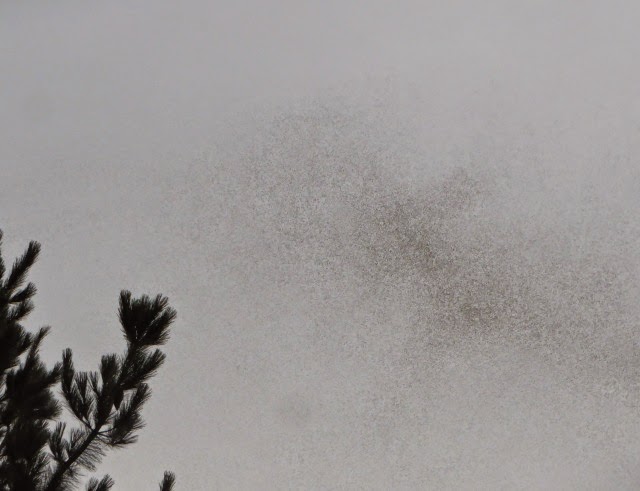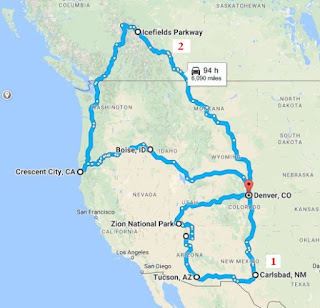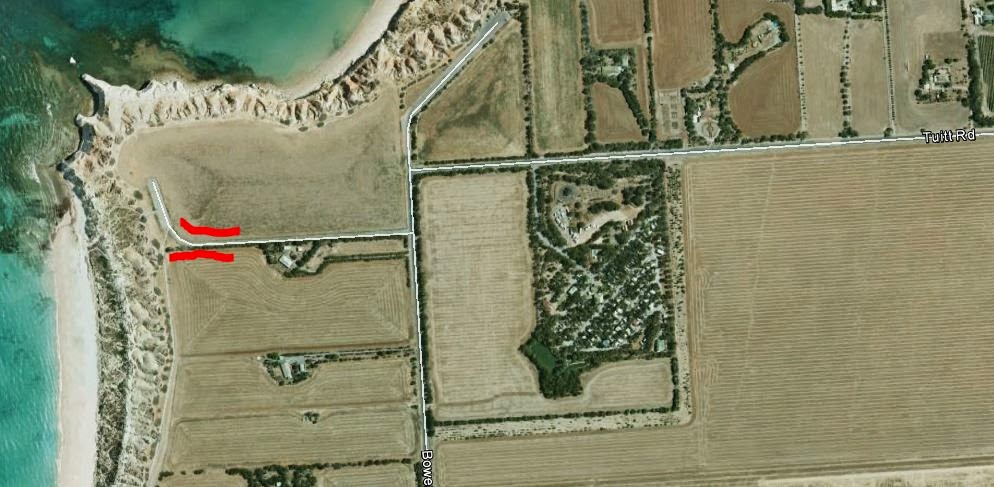Bursaria starts to deliver the goods!
When we first started to think about regenerating the bush on our property we consulted Greening Australia and Angela from that organisation visited us. She was very pleased to notice some Bursaria spinosa growing near our creek and said it was a good bird attractor.
On our trip to the Brindabellas last weekend Ian Fraser also commented about Bursaria attracting birds. Of course, Ian being the naturalist he is, he explained that this was because insects are attracted to the flowers and birds come along for some arthropod a la mode. When this comment was made Frances said something to the effect that "I foresee you spending a lot of time with your camera looking at the Bursaria !" As usual, spot on.
It was interesting that for the first few days on visiting the biggest clump of Bursaria I found few insects. I guess that this just meant the flowers hadn't developed full scent or nectar flow by that stage. Here is a shot of the habitat.
The slope here is fairly steep running down to Whiskers Creek: nearly all the Bursaria on our propery is close to one of the Creeks. It seems to like/need the humidity.
Here is a close up of some of the flowers:
The vernacular name for this species is Blackthorn. I am not sure about the black, but the 'thorn' element of the name is very correct.
It can be rather flesh-reducing trying to get through such armament to get a close photograph of an insect. This is particularly the case when one also has a small dog, actively exploring various rock and fallen trees, on a lead. Much as I enjoy her company, after the second occasion she pulled me off my rocky perch so that she could investigate a skink, she was returned to her cushion in the house!
This next image shows a section of a flower head in which at least 4 insect species are present.
Other more colourful ones (names to be added) soon became evident, often buried in the blossom ..
.. but occasionally emerging.
One of the issues seems to be that the insects don't stay still in these bushes. This gives rise to images such as this
showing the dorsal abdomen of a Fiddle Beetle (note the design) Eupoecila australasiae disappearing out of shot. The Flower Scarabs Polystigma punctata didn't even stay around that long. This is in contrast to the behaviour of insect on Asteraceae where the flat surface allows them to be moved around and photographed at leisure.
At times the instability plays into one's hands. This allows one to get shots of the underside of the beetle
and the overside (? why not - over is the opposite of under)!
before returning the insect to the Bursaria.
I am interested that in the last image above the wing cases (elytra) appear to have a brownish cast: this is more in conformation with other images of this species.
At the risk of diverting from purpose of this blog I will put in 2 final photos showing how the Soldier Beetles stick to daisies to the point of causing the flowers to fall to the ground. (The beetles are also attaching themselves to our lawn grass.)
On our trip to the Brindabellas last weekend Ian Fraser also commented about Bursaria attracting birds. Of course, Ian being the naturalist he is, he explained that this was because insects are attracted to the flowers and birds come along for some arthropod a la mode. When this comment was made Frances said something to the effect that "I foresee you spending a lot of time with your camera looking at the Bursaria !" As usual, spot on.
It was interesting that for the first few days on visiting the biggest clump of Bursaria I found few insects. I guess that this just meant the flowers hadn't developed full scent or nectar flow by that stage. Here is a shot of the habitat.
The slope here is fairly steep running down to Whiskers Creek: nearly all the Bursaria on our propery is close to one of the Creeks. It seems to like/need the humidity.
Here is a close up of some of the flowers:
The vernacular name for this species is Blackthorn. I am not sure about the black, but the 'thorn' element of the name is very correct.
It can be rather flesh-reducing trying to get through such armament to get a close photograph of an insect. This is particularly the case when one also has a small dog, actively exploring various rock and fallen trees, on a lead. Much as I enjoy her company, after the second occasion she pulled me off my rocky perch so that she could investigate a skink, she was returned to her cushion in the house!
This next image shows a section of a flower head in which at least 4 insect species are present.
Other more colourful ones (names to be added) soon became evident, often buried in the blossom ..
.. but occasionally emerging.
One of the issues seems to be that the insects don't stay still in these bushes. This gives rise to images such as this
showing the dorsal abdomen of a Fiddle Beetle (note the design) Eupoecila australasiae disappearing out of shot. The Flower Scarabs Polystigma punctata didn't even stay around that long. This is in contrast to the behaviour of insect on Asteraceae where the flat surface allows them to be moved around and photographed at leisure.
At times the instability plays into one's hands. This allows one to get shots of the underside of the beetle
and the overside (? why not - over is the opposite of under)!
before returning the insect to the Bursaria.
I am interested that in the last image above the wing cases (elytra) appear to have a brownish cast: this is more in conformation with other images of this species.
At the risk of diverting from purpose of this blog I will put in 2 final photos showing how the Soldier Beetles stick to daisies to the point of causing the flowers to fall to the ground. (The beetles are also attaching themselves to our lawn grass.)



















Comments
I've just written an article called "Love your Bursaria" for a newsletter for our local Conservation Management Network. I came across your blog while searching for a suitable Bursaria photo which included insect activity. Is it possible to include one of your photos (acknowledging you as photographer)? You can check out my website at http://fsccmn.com.au/
to see what kind of newsletter it is. Cheers, Alison info@fsccmn.com.au
You are most welcome to use any of the images on my blog, and thank you for asking! I can email you a bigger image if you need it.
If you'd like to attribute it to "Martin Butterfield" that would be great.
Now to return to reading your Newsletter- of particular interest to me as we used to have a weekender on Blackfellows Lake at Kalaru!
Best regards
Martin